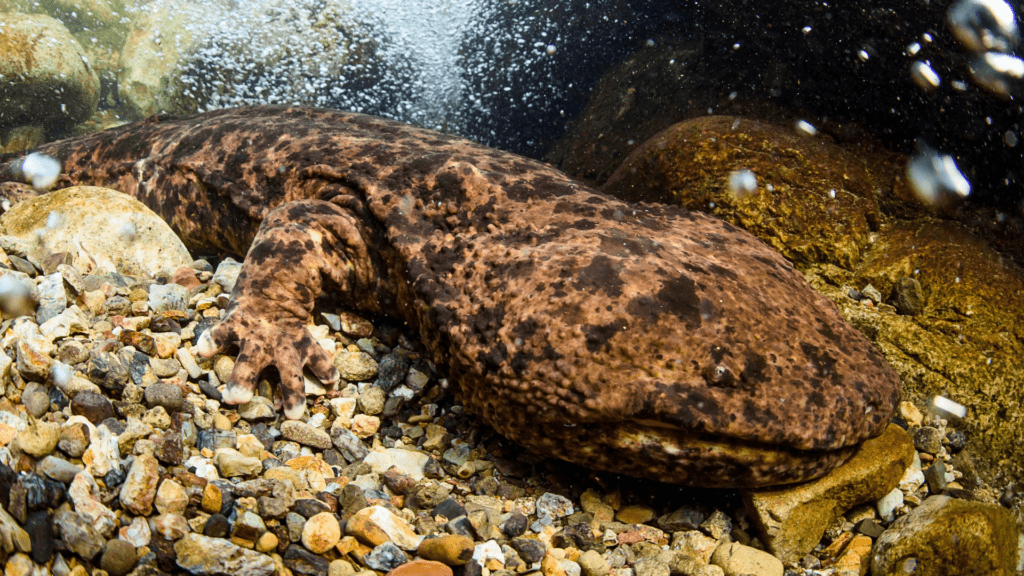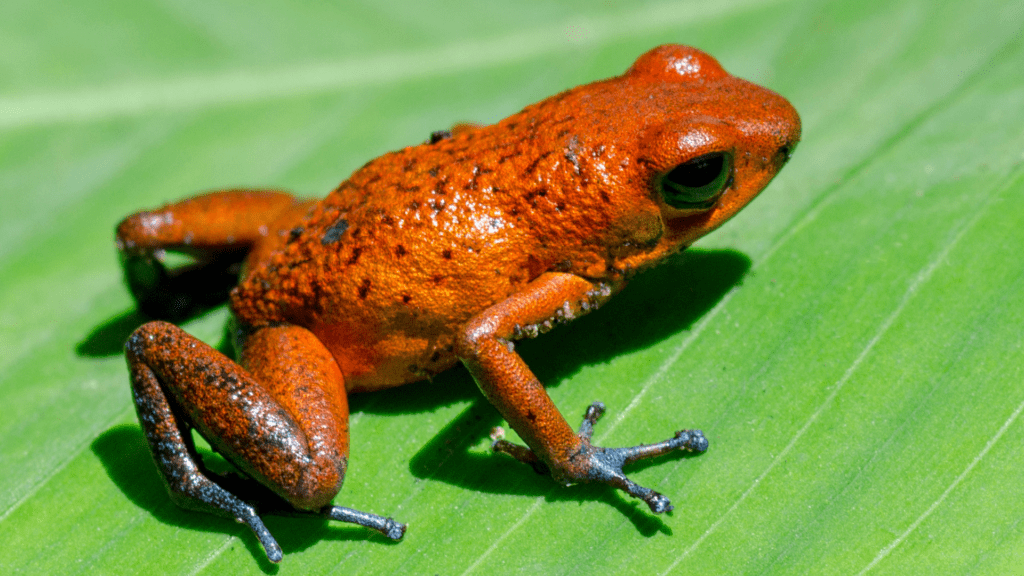Green Frog, scientifically known as Rana clamitans, is a large amphibian commonly found in the eastern regions of the United States and Canada. While often mistaken for the American green tree frog or the Australian green tree frog, the Green Frog is a distinct species with unique characteristics. This guide will explore its scientific classification, physical description, habitat, diet, reproduction, behavior, and care requirements.
Scientific Classification
Kingdom: Animalia
Phylum: Chordata
Class: Amphibia
Order: Anura
Family: Ranidae
Genus: Rana
Scientific Name: Rana clamitans
Phylum: Chordata
Description
The Green Frog (Rana clamitans) is a large and distinctive species, with a remarkable size difference between males and females. Females typically grow larger than males, which is a common trait in many amphibian species. The female Green Frog has eyes and tympanum (eardrums) that are roughly the same size, contributing to a balanced appearance. In contrast, the male Green Frog is known for its exaggerated tympanum, which is noticeably larger than its eyes, making it a key distinguishing feature. Additionally, males often display a vibrant yellow throat, which is particularly visible during the mating season when the frog calls to attract mates and defend its territory.
Size:
Fully grown Green Frogs typically range from 5 to 10 cm (2–4 inches) in length, though some individuals can grow slightly larger depending on environmental factors and food availability. Their size is one of the defining characteristics that set them apart from other frog species.
Color:
These frogs showcase a beautiful green coloration, which may range from a light, bright green to a darker, more olive shade. The dorsum of the Green Frog often features a mix of green and greenish-brown hues, with scattered black spots that help them blend into their environments, such as aquatic plants and muddy banks. The legs of the Green Frog are adorned with dark black stripes, which contrast with the overall green body. Their bellies are typically white or pale, which provides a sharp contrast to the darker dorsal side. This coloration helps the Green Frog with camouflage, both in water and on land.
A key identifying feature of the Green Frog is the seam-like skin folds that run down its back. These folds are easily visible and can help distinguish the Green Frog from similar species, such as the bullfrog. These skin folds are not just for show; they also play a role in the frog’s overall flexibility and ability to move swiftly when threatened. When viewed from the side, these folds are often described as “seams” and create a smooth, streamlined appearance that facilitates fast swimming. The presence of these folds, combined with their coloration and size, makes the Green Frog one of the more easily recognizable amphibians in North America.
Green Frogs also have well-developed limbs, with strong hind legs that allow them to make impressive leaps, often to escape predators or to navigate through their environment quickly. Their long, webbed feet make them strong swimmers, while their short forelimbs assist in climbing and maneuvering through vegetation.
In addition to their physical features, the Green Frog’s skin texture is worth noting. It is generally smooth, yet slightly slimy to the touch, helping them retain moisture in their mostly aquatic environment. This slimy layer serves as protection against infections and parasites, as well as a deterrent to predators.
By understanding the distinct appearance and characteristics of the Green Frog, it’s easier to appreciate how they adapt and thrive in a variety of habitats. Their size, coloration, and unique features contribute to their success as one of the more widespread frog species across North America

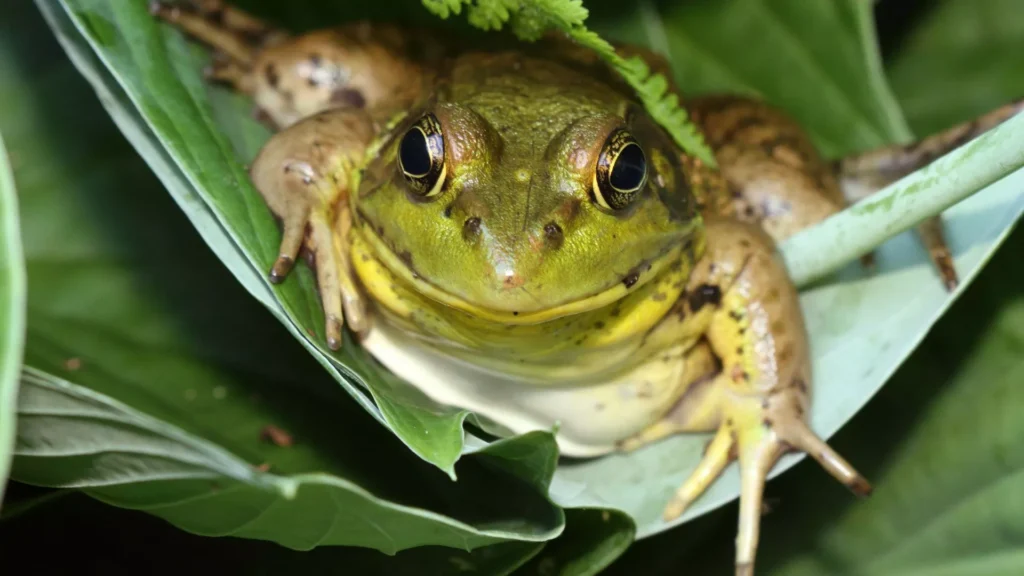
call
The male Green Frog is particularly famous for its unique and loud call, which is often likened to the sound of a banjo string being plucked. This sound is produced as a single, resonant note that carries over the water, and it serves multiple important functions in the frog’s life. While the call is most commonly associated with mating, it also plays a significant role in territorial defense. Each male frog claims and defends its own area, often a small section of pond or swamp, and the call acts as an audible boundary marker to warn other males of the established territory.
The call is produced by the male using its vocal sacs, which inflate dramatically when the sound is emitted. These sacs resonate to produce the deep, echoing note that can travel over long distances, especially during the warmer months when Green Frogs are most active. The intensity and frequency of the call can vary depending on environmental factors, but the primary function is to attract females during the breeding season.
Interestingly, the male’s call is not just a random sound. It is a vital part of his courtship ritual, signaling his fitness as a mate. Female Green Frogs tend to favor males with louder, more consistent calls, as this indicates a stronger, healthier frog capable of defending a prime territory. In turn, these calls are also an effective way to keep other males at bay, preventing them from encroaching on the calling frog’s space.
While the call is most common during the breeding season, it can sometimes be heard throughout the year, especially during the night. Male frogs may call intermittently throughout the night to maintain their territorial claims or to respond to calls from other males nearby
Habitat and Distribution
Green Frogs are versatile creatures, thriving in a wide variety of shallow freshwater habitats. They are typically found in ponds, lakes, slow-moving streams, swamps, marshes, and even roadside ditches. These frogs have adapted well to environments where the water is still or slow-moving, which provides them with both shelter and abundant food sources. They are often seen near the edges of these water bodies, where the vegetation is dense enough to provide both cover and a suitable environment for breeding.
The Green Frog’s distribution spans much of the eastern United States, from the Great Lakes region down to the Gulf of Mexico, and extends into parts of Canada, particularly in the southeastern corner of Manitoba. In these regions, populations of Green Frogs are particularly dense, taking advantage of the temperate climates and ample freshwater resources. They are particularly common in areas where there is a mix of both aquatic and terrestrial habitats, as this provides them with the ideal conditions for feeding, mating, and shelter.
While they are well-suited to living in freshwater environments, Green Frogs are highly sensitive to changes in water quality and temperature. They are more likely to be found in clean, oxygenated water that is free from pollutants. Consequently, urbanization and habitat destruction pose significant threats to Green Frog populations in certain regions, as these changes can lead to reduced habitat availability.
Green Frogs are primarily active during the warmer months of the year, often seen basking in the sun or hunting for food near the water. They are highly adaptable and can thrive in a wide range of freshwater ecosystems, from quiet forest ponds to more open, sunlit marshes. When threatened by predators or disturbances, Green Frogs are quick to leap into the water for safety, where they can take advantage of their strong swimming abilities to escape.
In some areas, such as the southern United States, Green Frogs are commonly found in man-made environments like reservoirs and irrigation ditches, proving their ability to adapt to both natural and altered landscapes. They also seem to favor environments with aquatic plants, which not only provide camouflage but also serve as a source of food for their tadpoles and juvenile frogs.
Overall, the Green Frog’s broad distribution and ability to thrive in a variety of shallow freshwater habitats make it one of the most common and well-known amphibians in North America.
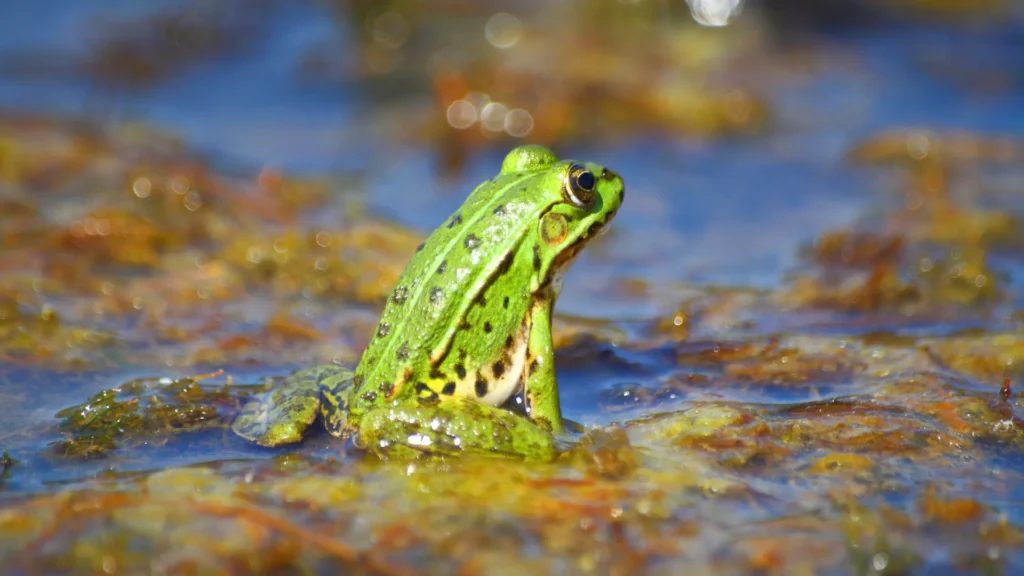
Diet
Opportunistic Feeding Habits
Green Frogs are renowned for their opportunistic feeding behaviors, consuming a wide variety of prey that fits within their mouths. Their diet is highly adaptable, reflecting their ability to thrive in a variety of freshwater environments. These frogs have developed remarkable hunting skills, using both their quick reflexes and keen eyesight to capture prey in the water and on land.
Primary Diet Components
Green Frogs predominantly feed on invertebrates, such as insects, worms, and crustaceans. They are also known to eat smaller fish, snails, and tadpoles when the opportunity arises. Their versatile feeding habits allow them to take advantage of any available food source.
Hunting Techniques and Versatility
In addition to smaller aquatic creatures, Green Frogs are known to capture smaller frogs using their powerful jaws. They even prey on juvenile or slow-moving small snakes, further demonstrating their adaptability as predators. This makes them highly versatile hunters, capable of thriving in a range of ecosystems by eating whatever is available.
Tadpole Diet
While adult Green Frogs are carnivorous, their tadpoles are primarily herbivores. They feed on algae, scraping it from submerged rocks and vegetation, and also consume aquatic plants. This plant-based diet helps to maintain water quality, contributing to the health of their aquatic ecosystems and providing essential nutrients for their growth.
Transition to Carnivorous Diet
As Green Frogs mature, their diet becomes more carnivorous, though their opportunistic feeding habits remain. They continue to eat whatever prey is most readily available, further emphasizing their adaptability and flexibility. This dietary transition is essential for their survival as they adapt to different habitats, from stagnant ponds to flowing streams.
Adaptability in Feeding Habits
The dietary flexibility of Green Frogs is key to their success. Whether consuming small invertebrates, fish, or even other frogs, these amphibians are equipped to maintain a diverse and balanced diet, allowing them to thrive in various ecosystems across their range.
Reproduction
Breeding Season and Territorial Behavior
Breeding in Green Frogs occurs during the warmer months, with the peak season typically beginning in April and continuing through mid-August. During this time, male Green Frogs become particularly vocal, using their distinctive calls to attract females and defend their territories. These calls, which sound like a plucked banjo string, are essential for establishing dominance and signaling the presence of a mate. Unlike many other frog species, which gather in large breeding groups, male Green Frogs prefer to call individually from their own established territories. This behavior is a key part of their reproductive strategy, as it minimizes competition with other males and allows them to defend their own space while courting females.
Preferred Breeding Grounds
Green Frogs prefer permanent or semi-permanent freshwater bodies, such as ponds, lakes, swamps, and streams, as their breeding grounds. These environments offer the right conditions for their eggs to develop, with stable water levels and abundant submerged vegetation where the eggs can attach securely.
Mating Process and Egg Laying
Once a female Green Frog has been successfully attracted by the male’s call, the mating ritual begins. During this process, the male grasps the female with his forelimbs in a position called amplexus, which is common in many frog species. As the female lays her eggs, the male releases sperm to fertilize them externally.
Tadpole Development and Metamorphosis
A single female Green Frog is capable of laying up to 4,000 eggs, which are typically deposited in clutches on submerged vegetation in the breeding site. These eggs are initially translucent but soon develop into black specks as they mature. The tadpoles hatch from the eggs and begin their aquatic life as small, olive-green creatures. At first, they are iridescent from below, giving them a unique shimmering appearance that can make them harder to spot in their aquatic environments.
The tadpoles feed primarily on algae and aquatic plants, gradually growing larger as they undergo metamorphosis. This process can take approximately 400 days, after which the tadpoles transform into froglets, small juvenile frogs that are fully formed but still not fully mature. The metamorphosis is a gradual process, and during this time, the tadpoles lose their tails and develop limbs, transitioning from fully aquatic organisms to more terrestrial amphibians.
Sexual Maturity
Two recognized subspecies exist:
- Bronze Frog
- Northern Green Frog
These subspecies differ significantly from their arboreal cousins, such as the American green tree frog and the Australian green tree frog.
In terms of sexual maturity, male Green Frogs typically reach reproductive capability by around one year of age. Females, however, take slightly longer, typically reaching sexual maturity between 2 and 3 years of age. This difference in maturation time is common in many amphibian species, with males often maturing faster to ensure they can participate in the breeding season as soon as possible. Once mature, both males and females participate in the reproductive cycle each year, contributing to the continued success of the species.
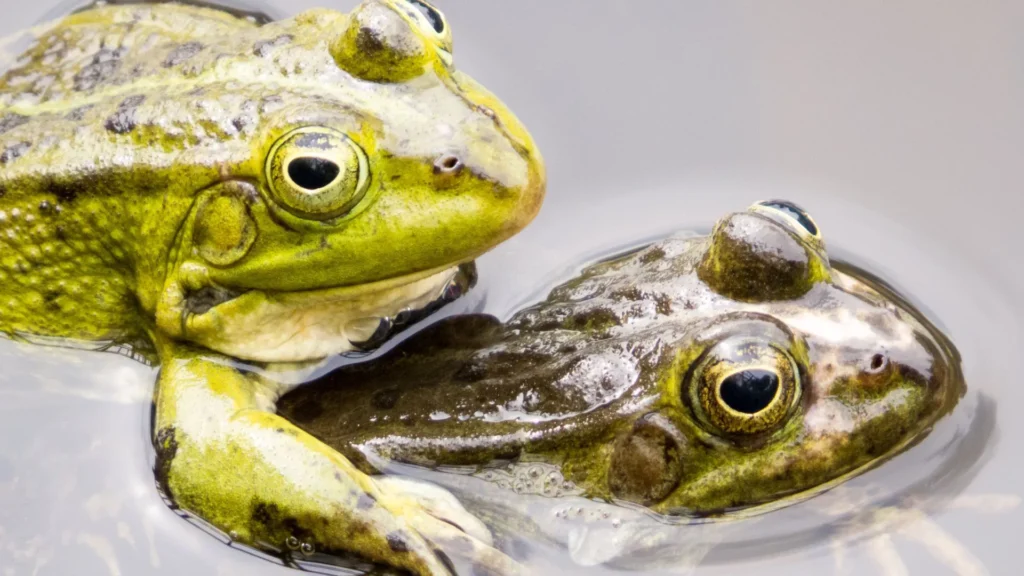
Behavior
Habitat Preferences
Adult Green Frogs are predominantly aquatic and prefer to remain in or near water, where they can find food, shelter, and avoid predators. They are often seen sitting quietly on submerged rocks or floating on the water’s surface, waiting for prey to pass by. Despite their strong association with aquatic habitats, Green Frogs are quite versatile and can adapt to a variety of wet environments.
Juvenile Behavior and Terrestrial Habitats
In contrast to adults, juvenile Green Frogs are often found on land, particularly in moist or damp areas. These young frogs are more likely to be spotted in wet grass, mud, or soil where they can hide and hunt for smaller prey. Their terrestrial behavior is typically observed when they are still developing, but as they mature, they tend to spend more time in the water.
Activity Patterns
Green Frogs are generally diurnal, meaning they are most active during the day. Their daily activities revolve around foraging for food, basking in the sun, and defending their territories. During the daytime, they are frequently seen sitting on rocks, logs, or water plants, observing their surroundings and waiting for potential prey. Their sharp eyesight allows them to spot small animals moving around them, which they can quickly capture.
Nighttime Behavior
Although Green Frogs are mostly active during the day, their calls may occasionally be heard at night, particularly during warm summer months. Their distinctive calls, which sound like a plucked banjo string, are used by males to attract mates or defend their territories. These calls can sometimes be heard even in the late evening, especially if the frog is in a quiet, secluded area near a water body.
Defensive and Territorial Behaviors
Green Frogs are known to be territorial, especially during the breeding season. Male frogs will often call from their territories to ward off other males and attract females. This territorial behavior helps ensure that they have access to mates and a secure environment for breeding. In addition, Green Frogs have a keen sense of their surroundings and will leap into the water at the slightest sign of danger. Their ability to make quick escapes and their camouflage within aquatic vegetation make them well-suited for evading predators.
Social Interactions
Although Green Frogs are typically solitary, males will engage in vocal competition during the breeding season to establish dominance and attract mates. These vocalizations are an important part of their social structure, as they help males stake out their territory and signal to females that they are ready to mate. Outside of the breeding season, these frogs are generally less social and prefer to spend time alone.
Care Sheet for Green Frogs
Green Frogs can make fascinating pets due to their adaptability and ease of care. However, providing them with an environment that closely mimics their natural habitat is crucial for their health and well-being. Below are essential guidelines for properly caring for Green Frogs, covering their habitat, diet, hygiene, and general maintenance.
1. Habitat Setup
Tank Size and Environment
- A 10-gallon aquarium is sufficient for one or two frogs, but a larger tank is recommended for multiple individuals.
- The tank should include a half-land, half-water setup to replicate their natural habitat.
- Ensure the enclosure is well-ventilated and securely covered to prevent escapes.
Substrate and Water Requirements
- Use moist soil, sphagnum moss, or coconut fiber for the land portion to maintain humidity.
- Provide a shallow water dish (3-4 inches deep) with fresh, dechlorinated water.
- Change the water daily to prevent bacterial growth and keep the frog healthy.
Temperature and Lighting
- Maintain a temperature range of 21–27°C (70–80°F) during the day and slightly cooler at night.
- A UVB fluorescent lamp is beneficial, as it helps the frog synthesize vitamin D3 and absorb calcium.
- Avoid direct sunlight exposure, as it may cause the enclosure to overheat.
Hiding Spots and Decorations
- Provide logs, bark pieces, or artificial caves for the frog to hide and feel secure.
- Aquatic plants or floating vegetation can enhance the frog’s sense of safety and provide additional hiding places.
2. Feeding and Nutrition
Diet for Adult Green Frogs
Green Frogs are carnivorous and require a varied diet to stay healthy. Their diet includes:
Live insects (crickets, mealworms, and earthworms)
Small aquatic creatures (crayfish, small fish, and snails)
Occasionally, other amphibians (such as smaller frogs)
Tip: Dust insects with a calcium supplement twice a week to support bone health.
Diet for Tadpoles
Unlike adult frogs, Green Frog tadpoles are primarily herbivorous and should be fed:
Algae and aquatic plants
Fish flakes and steamed vegetables
Zooplankton
Avoid feeding tadpoles celery, lettuce, or processed human foods, as they lack the necessary nutrients.. Hygiene and Tank Maintenance
Keeping the frog’s enclosure clean is essential to prevent diseases and maintain water quality.
Weekly Cleaning Routine
- Remove uneaten food and waste daily to avoid contamination.
- Clean the water dish and replace the water every day.
- Wash tank decorations (rocks, bark, logs) with hot water weekly.
Deep Cleaning Process (Every 2-3 Weeks)
- Transfer the frog to a temporary enclosure.
- Use a 1% bleach solution to disinfect the tank, but ensure thorough rinsing to remove any chemical residue.
- Wipe the enclosure dry before reintroducing the frog.
Tip: A tank vacuum cleaner or turkey baster can help remove dirty water without disturbing the habitat.
4. General Care Tips
Monitor the frog’s health—a healthy Green Frog should be alert, active, and have smooth, moist skin.
Avoid handling too frequently, as their skin is sensitive to oils and chemicals from human hands.
Observe their behavior—lethargy, loss of appetite, or discoloration may indicate illness.
Provide a stress-free environment by minimizing loud noises and excessive movement around the tank.

Lifespan and Conservation Status of Green Frogs
Lifespan
With proper care, Green Frogs can live up to 5–8 years, bringing enjoyment to their owners for a long time.
The average lifespan of a Green Frog ranges between 5 to 8 years, though some individuals may live longer in protected environments with minimal threats.
Their survival depends on various factors, including habitat conditions, availability of food, and predation risks.
In the wild, predators such as birds, snakes, and larger amphibians pose a significant threat, reducing their lifespan.
In captivity, with proper care, Green Frogs may live longer due to the absence of predators and stable food sources.
Conservation Status
Green Frogs are not considered endangered and maintain a stable population across their natural range.
Their widespread distribution in the eastern United States and Canada ensures that their numbers remain healthy.
While they are not currently at risk, habitat destruction, pollution, and climate change can impact local populations.
Conservation efforts focus on preserving wetland habitats, which are crucial for their breeding and survival.
Interesting Facts About Green Frogs
Green Frogs have several unique characteristics that make them fascinating creatures. From their exceptional vision to their specialized hearing abilities, these amphibians have evolved remarkable adaptations for survival.
1. Exceptional Vision
Green Frogs have large, bulging eyes, giving them a wide field of view and allowing them to detect movement from multiple angles.
Their night vision is well-developed, enabling them to see in low-light conditions, which is beneficial for both hunting and avoiding predators.
2. Advanced Hearing Abilities
Their tympanum (eardrum) is located just behind their eyes and functions as a specialized patch of tissue that vibrates in response to sound waves.
These vibrations are transmitted to the frog’s brain, allowing it to interpret different sounds, such as approaching predators or the calls of other frogs.
Males have a larger tympanum than their eyes, which helps them detect the calls of potential rivals and mates from a distance.
3. Unique Hunting Strategy 🦗
Green Frogs do not chase their prey like some predators. Instead, they rely on a sit-and-wait hunting technique.
They remain motionless and patiently wait for prey to come within reach before striking with lightning-fast reflexes.
Their sticky tongue and strong jaws help them capture and consume a variety of food, including insects, small fish, and even other amphibians.
4. Survival Adaptations
🟢 When sensing danger, Green Frogs instantly leap into the water to escape predators.
🟢 Their camouflaged green or brown coloration helps them blend into their environment, making them less visible to threats.
🟢 If caught, they can emit a loud distress call to startle predators and increase their chances of escape.
5. Fascinating Life Cycle
Green Frog tadpoles take over a year to metamorphose into froglets, which is longer than many other frog species.
Males reach sexual maturity in about one year, while females take two to three years before they can reproduce.
Conclusion
Green Frogs are fascinating amphibians, known for their unique sensory abilities, adaptability, and survival strategies. Their sharp vision, keen hearing, and opportunistic feeding habits allow them to thrive in diverse environments. These traits make them not only an important part of their ecosystem but also an interesting species to study.
Additionally, Green Frogs can make excellent pets when provided with proper care. A well-maintained habitat, a nutritious diet, and regular hygiene are essential for their health and well-being in captivity. Whether in the wild or as pets, these resilient amphibians continue to captivate enthusiasts with their distinctive behaviors and adaptability.
faq’s
1. Where are Green Frogs commonly found?
Green Frogs are primarily found in the eastern United States and parts of Canada, including Ontario. They inhabit freshwater environments such as ponds, lakes, streams, and swamps.
2. How can you distinguish a Green Frog from a Bullfrog?
Green Frogs have distinct dorsolateral ridges running down their back, while Bullfrogs lack these ridges. Additionally, Green Frogs are generally smaller in size.
3. Are Green Frogs poisonous?
No, Green Frogs are not poisonous. They are harmless to humans and do not produce toxins like some other amphibians.
4. How big do Green Frogs grow?
Adult Green Frogs typically range between 5 to 10 cm (2–4 inches) in length. Females are usually larger than males.
5. What do Green Frogs eat?
Green Frogs are opportunistic feeders, consuming insects, spiders, fish, snails, smaller frogs, and even small snakes. Their tadpoles mainly feed on algae and aquatic plants.
6. Do Green Frogs make good pets?
Yes, Green Frogs can be kept as pets if their habitat is properly maintained. They require a half-land, half-water setup, a balanced diet, and regular tank cleaning.
7. How long do Green Frogs live?
In the wild, Green Frogs typically live for about 5 to 8 years, depending on environmental conditions and predation risks.
8. What is the sound of a Green Frog’s call?
The call of a male Green Frog resembles the sound of a plucked banjo string. They use this call to establish territory and attract mates.
9. When is the breeding season for Green Frogs?
Green Frogs breed from April to mid-August. Females can lay up to 4,000 eggs, which are attached to submerged vegetation.
10. Are Green Frogs endangered?
No, Green Frogs are not endangered. They have stable populations across their range and adapt well to different aquatic habitats.
